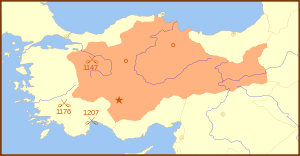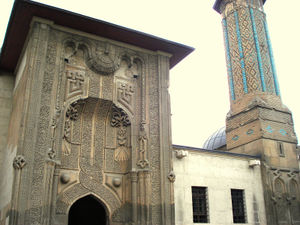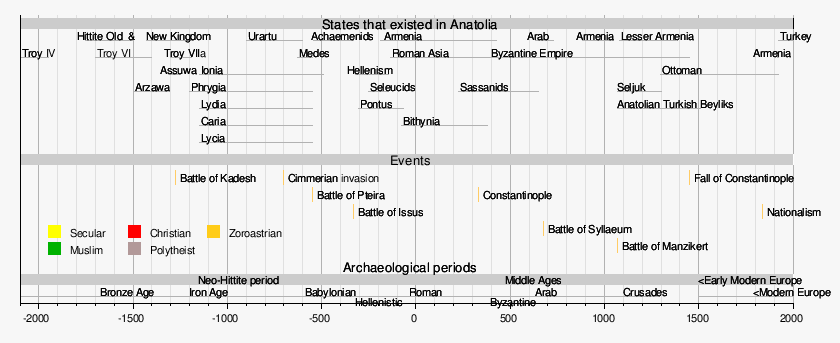Sultanate of Rûm
| History of Turkey |
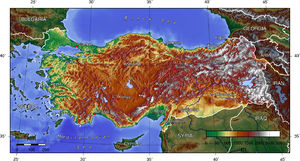 |
| Seljuq dynasty |
1071–1325 |
| • Great Seljuq Empire |
1071–1194 |
| • Sultanate of Rûm |
1075–1307 |
| • under the Seljuks |
after 1071 |
| Anatolian Beyliks |
| • Chaka of Smyrna |
1081–1098 |
| • Ahlatshahs |
1085–1207 |
| • Danishmend |
1071–1178 |
| • Mengücek |
1072–1277 |
| • Saltuklu |
1072-1202 |
|
| under the Ilkhanate |
1243–1335 |
| Anatolian Beyliks |
| • Karamanoglu |
1250–1487 |
| • Ottomans |
1302–1922 |
| • Aydınoğlu |
1300–1425 |
| • Beylik of Teke |
1321–1425 |
| • Candaroğlu |
1291–1461 |
| • Dulkadir |
1348–1507 |
| • Germiyan |
1300–1429 |
| • Eşrefoğlu |
1285-1326 |
| • Eretna |
1335–1390 |
| • Hamidoğlu |
1300-1391 |
| • Kadi Burhan al-Din |
1381–1398 |
| • Karesi |
1296–1357 |
| • Beylik of Lâdik |
1262–1391 |
| • Pervâneoğlu |
1262–1391 |
| • Menteşe |
1261–1424 |
| • Ramazanoğlu |
1352–1608 |
| • Saruhan |
1300–1410 |
| • Sâhipataoğlu |
1275–1341 |
|
| Ottoman Dynasty |
1302–1922 |
| Occupation |
1918–1923 |
| Republic of Turkey |
from 1923 |
|
|
|
|
The Sultanate of Rûm (Modern Turkish:Rum Selçuklu Devleti[2] or Anadolu Selçuklu Devleti[2] or Türkiye Selçuklu Devleti) was the continuation of the Great Seljuq Empire in Anatolia, in direct lineage from 1077 to 1307, with capitals first at İznik and then at Konya. Since the court of the sultanate was highly mobile, cities like Kayseri and Sivas also functioned at times as capitals. At its height the sultanate stretched across central Anatolia from the Antalya-Alanya shoreline on the Mediterranean coast to the territory of Sinop on the Black Sea. In the east, the sultanate absorbed other Turkish states and reached Lake Van. Its westernmost limit was near Denizli and the gates of the Aegean basin.
The term "Rûm" comes from the Arabic word for the Roman Empire. The Seljuks called the lands of their sultanate Rum because it had been established on territory long considered "Roman", i.e. Byzantine, by Muslim armies.[3] The state is occasionally called the Sultanate of Konya (or Sultanate of Iconium) in older western sources.
The sultanate prospered, particularly during the late 12th and early 13th centuries when it took from the Byzantines key ports on the Mediterranean and Black Sea coasts. Within Anatolia the Seljuks fostered trade through a program of caravanserai-building, which facilitated the flow of goods from Iran and Central Asia to the ports. Especially strong trade ties with the Genoese formed during this period. The increased wealth allowed the sultanate to absorb other Turkish states that had been established in eastern Anatolia after the Battle of Manzikert: the Danishmends, the Mengücek, the Saltuklu, and the Artuklu. Seljuk sultans successfully bore the brunt of the Crusades but in 1243 succumbed to the advancing Mongols. The Seljuks became vassals of the Mongols, and despite the efforts of shrewd administrators to preserve the state's integrity, the power of the sultanate disintegrated during the second half of the 13th century and had disappeared completely by the first decade of the 14th.
In its final decades, the territory of the Seljuk Sultanate of Rûm saw the emergence of a number of small principalities or beyliks, among which that of the Osmanoğlu, known later as the Ottomans, rose to dominance.
Establishment
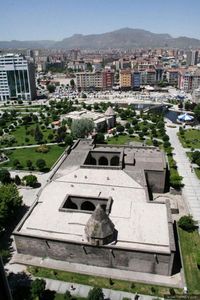
General view of Gevher Nesibe medical center (front) and school (back) in Kayseri, built between 1204-1210
In the 1070s, the Seljuk commander Suleyman bin Kutalmish, a distant cousin of Malik Shah and a former contender for the throne of the Great Seljuk Empire, came to power in western Anatolia. In 1075, he captured the Byzantine cities of Nicaea (İznik) and Nicomedia (İzmit). Two years later he declared himself sultan of an independent Seljuk state and established his capital at İznik.[4]
Suleyman was killed in Antioch in 1086 by Tutush I, the Seljuk ruler of Syria, and Suleyman's son Kilij Arslan I was imprisoned. When Malik Shah died in 1092, Kilij Arslan was released and immediately established himself in his father's territories. He was eventually defeated by soldiers of the First Crusade and driven back into south-central Anatolia, where he set up his state with capital in Konya. In 1107, he ventured east and captured Mosul but died the same year fighting Malik Shah’s son Mehmed Tapar.
Meanwhile, another Rum Seljuk, Melikshah (not to be confused with the Great Seljuk sultan of the same name), captured Konya. In 1116 Kilij Arslan's son, Mesud I took the city with the help of the Danishmends. Upon Mesud's death in 1156, the sultanate controlled nearly all of central Anatolia. Mesud's son, Kilij Arslan II, captured the remaining territories around Sivas and Malatya from the last of the Danishmends. At the Battle of Myriokephalon in 1176, Kilij Arslan also defeated a Byzantine army led by Manuel I Comnenus, dealing a major blow to Byzantine power in the region. Despite a temporary occupation of Konya in 1190 by German forces of the Third Crusade, the sultanate was quick to recover and consolidate its power.
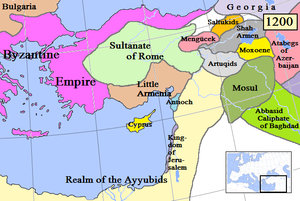
The Sultanate of Rûm and surrounding states, c. 1200.
After the death of the last sultan of Great Seljuk, Tuğrul III, in 1194, the Seljuks of Rum became the sole ruling representatives of the dynasty. Kaykhusraw I seized Konya from the Crusaders in 1205. Under his rule and those of his two successors, Kaykaus I and Kayqubad I, Seljuk power in Anatolia reached its apogee. Kaykhusraw's most important achievement was the capture of the harbour of Attalia (Antalya) on the Mediterranean coast in 1207. His son Kaykaus captured Sinop and made the Empire of Trebizond his vassal in 1214. He also subjugated Cilician Armenia but in 1218 was forced to surrender the city of Aleppo acquired from al-Kamil. Kayqubad continued to acquire lands along the Mediterranean coast from 1221 to 1225. In the 1220s, he sent an expeditionary force across the Black Sea to Crimea.[5] In the east he defeated the Mengüceks and began to pressure on the Artukid.
Downfall
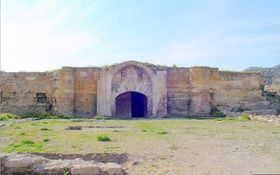
Hanabad caravanserai in Çardak (1230)
Kaykhusraw II (1237–1246) began his reign by capturing the region around Diyarbekir, but in 1239 he had to face an uprising led by a popular preacher named Baba Ishak. After three years, when he had finally quelled the revolt, the Crimean foothold was lost and the state and the sultanate's army had weakened. It is in these conditions that he had to face a far more dangerous threat, that of the expanding Mongols. Mongol forces took Erzurum in 1242 and in 1243, the sultan was crushed by Bayju in the Battle of Köse Dag (a mountain between the cities of Sivas and Erzincan) and the Seljuks henceforth began to owe allegiance to the Mongols and gradually became their vassals. The sultan himself had fled to Antalya after the 1243 battle, where he died in 1246, his death starting a period of tripartite, and then dual rule that lasted until 1260.
The Seljuk realm was divided among Kaykhusraw's three sons. The eldest, Kaykaus II (1246–1260), assumed the rule in the area west of the river Kızılırmak. His younger brothers, Kilij Arslan IV (1248–1265) and Kayqubad II (1249–1257) were set to rule the regions east of the river under Mongol administration. In October 1256, Bayju defeated Kaykaus II near Aksaray and all of Anatolia became officially subject to Möngke Khan. In 1260 Kaykaus II fled from Konya to Crimea where he died in 1279. Kilij Arslan IV was executed in 1265 and Kaykhusraw III (1265–1284) became the nominal ruler of all of Anatolia, with the tangible power exercised either by the Mongols or the sultan's influential regents.
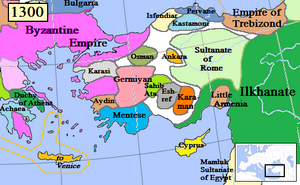
The declining Sultanate of Rûm, vassal of the
Mongols, and the emerging beyliks, c. 1300.
The Seljuk state had started to split into small emirates (Beyliks) that increasingly distanced themselves from both Mongol and Seljuk control. In 1277, responding to a call from Anatolia, the Mameluk sultan Baybars raided Anatolia and defeated the Mongols, temporarily replacing them as the administrator of the Seljuk realm. But since the native forces who had called him to Anatolia did not manifest themselves for the defense of the land, he had to return to his homebase in Egypt, and the Mongol administration was re-assumed, officially and severely.
Towards the end of his reign, Kaykhusraw III could claim direct sovereignty only over lands around Konya. Some of the Beyliks (including the Ottomans in their very beginnings) and Seljuk governors of Anatolia continued to recognize, albeit nominally, the supremacy of the sultan in Konya, delivering the khutba in the name of the sultans in Konya in recognition of their sovereignty, and the sultans continued to call themselves Fahreddin, the Pride of Islam. When Kaykhusraw III was executed in 1284, the Seljuk dynasty suffered another blow from internal struggles which lasted until 1303 when the son of Kaykaus II, Mesud II, established himself as sultan in Kayseri. He was murdered in 1307 as well as his son Mesud III soon afterwards. A distant relative to the Seljuk dynasty momentarily installed himself as emir of Konya, but he was defeated and his lands conquered by the Karamanoğlu in 1328. The sultanate's monetary sphere of influence lasted slightly longer and coins of Seljuk mint, generally considered to be of reliable value, continued to be used throughout the 14th century, once again, including by the Ottomans.
Art and Architecture
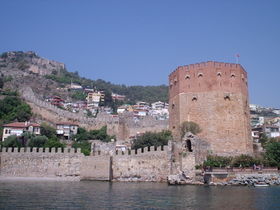
Kızıl Kule (
Red Tower) built between 1221–1226 by Kayqubad I in
Alanya
The exceptional period that flourished in Anatolia in the 12th and the 13th centuries, between the Crusades and the Mongol invasion, is marked by outstanding works of architecture and decorative arts.
Among these, the caravanserais (or hans), used as stops, trading posts and defense for caravans, and of which about a hundred structures were built during the Anatolian Seljuks period, are particularly remarkable. Their unequalled concentration in time and in Anatolian geography represent some of the most distinctive and impressive constructions in the entire history of Islamic architecture.
The largest caravanserai is the 1229-built Sultan Han on the road between the cities of Konya and Aksaray, in the township of Sultanhanı depending the latter city, enclosing 3,900 square meters. There are two caravanserais that carry the name "Sultan Han", the other one being between Kayseri and Sivas. Furthermore, apart from Sultanhanı, five other towns across Turkey owe their names to caravanserais built there. These are Alacahan in Kangal, Durağan, Hekimhan and Kadınhanı, as well as the township of Akkale/Akhan within Denizli metropolitan area. The caravanserai of Hekimhan is unique in having, underneath the usual inscription in Arabic with information relating to the edifice, two further inscriptions in Armenian and Syriac, since it was constructed by the sultan Kayqubad I's doctor (hekim) who is thought to have been a Christian by his origins, and to have converted to Islam. There are other particular cases like the settlement in Kalehisar site (contiguous to an ancient Hittite site) near Alaca, founded by the Seljuk commander Hüsameddin Temurlu who had taken refuge in the region after the defeat in the Battle of Köse Dağ, and had founded a township comprising a castle, a medrese, a habitation zone and a caravanserai, which were later abandoned apparently around the 16th century. All but the caravanserai, which remains undiscovered, was explored in the 1960s by the art historian/Ottoman archaeologist Oktay Aslanapa, and the finds as well as a number of documents attest to the existence of a vivid settlement in the site, such as a 1463-dated Ottoman firman which instructs the headmaster of the medrese to lodge not in the school but in the caravanserai.
The Dynasty
As regards the names of the sultans, there are variants in form and spelling depending on the preferences displayed by one source or the other, either for fidelity in transliterating the Persian-influenced variant of the Arabic script which the sultans used, or for a rendering corresponding to the modern Turkish phonology and orthography. Some sultans had two names that they chose to use alternatively in reference to their legacy. While the two palaces built by Alaeddin Keykubad I carry the names Kubadabad Palace and Keykubadiye Palace, he named his mosque in Konya as Alaeddin Mosque and the port city of Alanya he had captured as "Alaiye". Similarly, the medrese built by Gıyaseddin Keyhüsrev I in Kayseri, within the complex (külliye) dedicated to his sister Gevher Nesibe, was named Gıyasiye Medrese, and the one built by Izzeddin Keykavus I in Sivas as Izzediye Medrese.
| Sultan |
Reign |
Notes |
| Kutalmish |
1060–1064 |
Contended with Alp Arslan for succession to Great Seljuk throne. |
| Süleyman bin Kutalmish |
1075-1077 de facto rules Turkmen around İznik and İzmit; 1077–1086 recognised Rûm Sultan by Malik I |
Founder of Anatolian Seljuk Sultanate with capital in İznik |
| Kilij Arslan I |
1092–1107 |
First sultan in Konya |
| Melikshah |
1107–1116 |
|
| Masud I |
1116–1156 |
|
| 'Izz al-Din Kilij Arslan II |
1156–1192 |
|
| Giyath al-Din Kaykhusraw I |
1192–1196 |
First reign |
| Rukn al-Din Suleymanshah II |
1196–1204 |
|
| Kilij Arslan III |
1204–1205 |
|
| Giyath al-Din Kaykhusraw I |
1205–1211 |
Second reign |
| 'Izz al-Din Kayka'us I |
1211–1220 |
|
| 'Ala al-Din Kayqubad I |
1220–1237 |
|
| Giyath al-Din Kaykhusraw II |
1237–1246 |
After his death, sultanate split until 1260 when Kilij Arslan IV remained the sole ruler |
| 'Izz al-Din Kayka'us II |
1246–1260 |
|
| Rukn al-Din Kilij Arslan IV |
1248–1265 |
|
| 'Ala al-Din Kayqubad II |
1249–1257 |
|
| Giyath al-Din Kaykhusraw III |
1265–1284 |
|
| Giyath al-Din Masud II |
1284–1296 |
First reign |
| 'Ala al-Din Kayqubad III |
1298–1302 |
| Giyath al-Din Masud II |
1303–1308 |
Second reign |
See also
- Rûm Province, Ottoman Empire
- Anatolian beyliks
- Alaeddin Mosque (Konya, Turkey)
- Ince Minaret Medrese
- Karatay Medrese
- Timeline of the Sultanate of Rûm
- Byzantine–Seljuk Wars
References
- ↑ Grousset, Rene, The Empire of the Steppes: A History of Central Asia, (Rutgers University Press, 2002), 157;"...the Seljuk court at Konya adopted Persian as its official language.".
- ↑ 2.0 2.1 "Ayşe Hür - "Türkler Mu’dan mı Ergenekon’dan mı?" başlıklı yazısı - Taraf Gazetesi". Taraf.com.tr. http://www.taraf.com.tr/makale/623.htm). Retrieved 2010-08-24.
- ↑ Alexander Kazhdan, “Rūm” The Oxford Dictionary of Byzantium (Oxford University Press, 1991), vol. 3, p. 1816.
- ↑ Sicker, Martin, The Islamic world in ascendancy: from the Arab conquests to the siege of Vienna , (Greenwood Publishing Group, 2000), 63-64.
- ↑ A.C.S. Peacock, "The Saljūq Campaign against the Crimea and the Expansionist Policy of the Early Reign of 'Alā' al-Dīn Kayqubād" Journal of the Royal Asiatic Society, Vol. 16 (2006), pp. 133-149.
Sources
External links
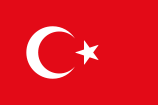 Turkey topics Turkey topics |
|
People and
biographies |
|
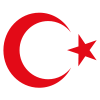 |
|
History
(timeline) |
|
Early
|
Sultanate of Rûm · Anatolian Turkish Beyliks
|
|
|
|
Rise · Growth · Stagnation · Decline · Dissolution
|
|
|
Republic
|
|
|
|
By topic
|
Constitutional · Economic · Military
|
|
|
Politics and
government |
President · Prime Minister · Parliament · Council of Ministers · Political parties · Elections · EU accession · Foreign relations · Military · Human rights · LGBT rights · Secularism · Ottomanism · Kemalism · Neo-Ottomanism · Deep state
|
|
| Legal system |
Constitution · Constitutional Court · Official Gazette · Crime · Law enforcement
|
|
| Geography |
Anatolia · Thrace · Regions · Provinces · Districts · Cities · Metropolitan centers · Environmental issues · Mountains · Islands · Rivers · Lakes · Peninsulas · Capes · Bays · Turkish Riviera
|
|
Economy and
transport |
Industries · Companies · Stock Exchange · Central Bank · Other banks · EU Customs Union · Southeastern Anatolia Project · Tourism · Currency · Railways · Aviation
|
|
| Demographics and Religion |
Turkish language · Languages of Turkey · Education · Religion · Islam · Turkish population · Turkish diaspora · Immigration
|
|
Culture and
media |
Ottoman architecture · Art · Cinema · Cuisine · Dance · Festivals · Folklore · Public holidays · Literature · Music · Smoking · Sport · Theatre · Wine · Newspapers · Radio stations · Television
|
|
| Symbols |
Emblem · Flag · Presidential Seal · National anthem |
|
| Portal |
|
|
Landmarks of the Seljuk Sultanate of Rûm and the Anatolian beyliks |
|
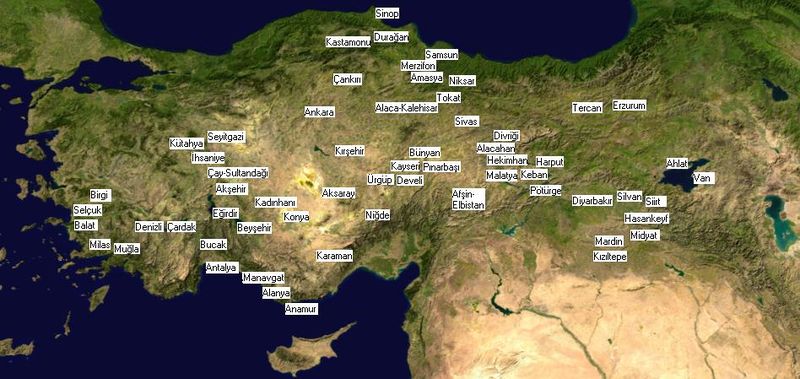
Locations of landmarks by the Seljuk Sultanate of Rûm and Anatolian beyliks, excepting the Ottomans, between 1071 and circa 1400
|
|
|
Seljuk Sultanate of Rûm |
|
Ancestor: Kutalmish • Founder: Suleyman I • Capital: İznik, then Konya
Important centers and extension: Konya • Kayseri • Sivas (1175) • Malatya (1178) • Alanya • Antalya
Dynasty: Suleyman I (1077-1086) •• Kilij Arslan I (1092-1107) •• Melikshah (1107-1116) •• Mesud I (1116-1156) •• Kilij Arslan II (1156-1192) •• Kaykhusraw I (1192-1196) •• Süleymanshah II (1196-1204) •• Kilij Arslan III (1204-1205) •• Kaykhusraw I (2nd reign) (1205-1211) •• Kaykaus I (1211-1220) •• Kayqubad I (1220-1237) •• Kaykhusraw II (1237-1246) •• Kaykaus II (1246-1260) •• Kilij Arslan IV (1248-1265) •• Kayqubad II (1249-1257) •• Kaykhusraw III (1265-1282) •• Mesud II (1282-1284) •• Kayqubad III (1284) •• Mesud II (2nd reign) (1284-1293) •• Kayqubad III (2nd reign) (1293-1294) •• Mesud II (3rd reign) (1294-1301) •• Kayqubad III (3rd reign) (1301-1303) •• Mesud II (4th reign) (1303-1307) • Mesud III (1307)
1243: Gradually vassalized to the Mongol Empire after the defeat suffered in the Battle of Köse Dag • 1307: Taken over by the Beylik of Karamanoğlu
Important works:
Palaces and Castles: Seljuk Palace in Konya (1190-1220) •• Kubadabad Palace in Beyşehir (1220-1230) •• Keykubadiye Palace in Kayseri (1220-1230) •• Alanya Kızıl Kule (Red Tower) and Shipyard constructions and widescale extension of Alanya Castle
Külliye (Complexes) and Dar al-Shifa (Medical Centers) and Medrese (Schools) and Mosques: Gevher Nesibe Külliye with Medical Center and Medical School and Mosque in Kayseri (1204-1210) •• Battal Gazi Külliye in Seyitgazi (1208) •• Karatay Medrese in Konya (1225) •• Ince Minaret Medrese in Konya (1258-1279) •• Atabeg Ferruh Darüşşifa in Çankırı (1236) •• Alâeddin Keykubad I Darüşşifa in Konya (1237) •• Torumtay Darüşşifa in Amasya (1266) •• Izzeddin Keykavus I Şifaiye Medrese and Medical Center (Darüşşifa) in Sivas (1218) •• Gökmedrese in Sivas (1271) •• Çifte Minaret Medrese in Sivas (1271) •• Alâeddin Mosque in Konya (1220) •• Alâeddin Mosque in Niğde (1220) •• Great Mosque of Malatya in Eskimalatya (Battalgazi) (1224) •• Hüsameddin Temurlu castle, caravanseai and medrese in Kalehisar, Alaca (~ 1250) •• Havadan Külliye in Develi (~1300)
Caravanserais: Ağzıkara Han caravanserai near Aksaray (1237) •• Ak Han caravanserai near Denizli (1254) •• Alaca Han caravanserai in Alacahan (~1280) •• Alara Han caravanserai near Manavgat •• Alay Han caravanserai near Aksaray (1190) •• Altınapa Han caravanserai between Beyşehir and Konya (1201) •• Angit Han caravanserai between Konya and Akşehir (1201) •• Burma Han caravanserai in Divriği (13th century) •• Çakallı Han caravanserai near Samsun (~ 1250) •• Çardak Han (Hanabad) caravanserai in Çardak (1230) •• Çay Han caravanserai in Çay (1279) •• Dokuzun Han caravanserai in Konya (1210) •• Eğirdir Han caravanserai in Eğirdir (1238) •• Ertokuş Han caravanserai near Eğirdir (1224) •• Eshab-i Kehf Han caravanserai near Afşin-Elbistan (~ 1225) •• Evdir Han caravanserai near Antalya (1224) •• Ezinepazar Han caravanserai near Amasya (1246) •• Goncalı Akhan caravanserai between Konya and Aksaray •• Hatun Han caravanserai between Amasya and Tokat •• Hekim Han caravanserai in Hekimhan (1220) •• Horozlu Han caravanserai near Konya (1249) •• İncir Han caravanserai near Bucak (1239) •• Kadın Han caravanserai in Kadınhanı (1223) •• Karatay Han caravanserai near Pınarbaşı (1241) • Kargı Han caravanserai near Antalya (1246) •• Kesikköprü Han caravanserai near Kırşehir (1268) •• Kırkgöz Han caravanserai near Antalya (1246) •• Kızılören Han caravanserai near Konya (1206) •• Kuruçeşme Han caravanserai near Konya (1210) ••Melleç Han caravanserai near Anamur (13th century) •• Mirçinge Han caravanserai near Divriği (13th century) •• Obruk Han caravanserai near Konya (1230) •• Öresin Han caravanserai near Aksaray (~ 1275) •• Pazar Han caravanserai near Tokat (1239) •• Zazadın Han caravanserai near Konya (1236) •• Şarapsa Han caravanserai near Alanya (1246) •• Sarı Han caravanserai near Ürgüp (1249) •• Sevserek Han caravanserai between Malatya and Pötürge (13th century) •• Sultan Han caravanserai between Konya and Aksaray (1229) • Sultan Han caravanserai near Bünyan between Kayseri and Sivas (1236) • Susuz Han caravanserai near Bucak (1246)
|
|
|
Anatolian beyliks |
|
|
Chaka (1081 - 1092) |
|
Founder: Chaka Bey • Capital: İzmir
Important centers and extension: Ephesus • Lesbos • Chios
1082: Submitted to the Seljuks of Turkey
|
|
|
|
Ahlatshahs (1100 - 1207) |
|
Founder: Sökmen el Kutbi • Capital: Ahlat
Important centers and extension: Silvan • Malazgirt • Erciş • Adilcevaz • Başkale • Eleşkirt • Van • Tatvan • Bitlis • Muş • Hani
Dynasty: Sökmen el Kutbi (1100-1112) • İbrahim bin Sökmen (? - ?) • Ahmed bin İbrahim (? - ?) • Sökmen the Second (1128 - 1185) • Seyfeddin Begtimur (1185 - 1193) • Aksungur (1193 - 1197) • Muhammed bin Begtimur (1185 - 1207)
1207: Submitted to the Ayyoubids
Important works: Ahlat Tombs
|
|
|
|
Artuklu (1102 - ) |
|
Ancestors: Eksük and his son Artuk, commander of Alparslan, from Döğer Oghuz Türkmen clan
Founder: Muinüddin Sökmen Bey • Capitals: Three branches in Hasankeyf, Mardin and Harput
Important centers and extension: Diyarbekir • Hasankeyf • Silvan • Mardin • Midyat • Harput • Palu • Aleppo (temporarily as of 1117)
Hasankeyf Dynasty or Sökmenli Dynasty: Müinüddin Sökmen Bey (1102-1104) • Sökmenli İbrahim Bey (1104 - 1131)
Mardin Dynasty or İlgazi Dynasty: Necmeddin İlgazi (1106-1122) • Hüsameddin Timurtaş (1122 - 1154) • Necmeddin Alp (1154 - 1176)
Harput Dynasty: Belek Bey (1112-1124) • Nureddin Muhammed (? - ?) • Sökmen the Second (? - ?)
Important works: Artuklu Palace in Diyarbakır • Widescale extension of Diyarbakır City Walls • Malabadi Bridge • Hasankeyf Bridge • Sökmenli Nasirüddevle Bîmaristan-ı Farukî Medical Center (Darüşşifa) in Silvan (1108) • Emineddin (brother of İlgazi) Medical Center (Darüşşifa) in Mardin (built between (1122) • Great Mosque of Silvan • Great Mosque of Mardin • Older Great Mosque of Midyat (Cami-i Kebir) • Great Mosque of Kızıltepe • Great Mosque of Harput • Artuklu Caravanserai in Mardin • İbrahim Shah Caravanserai near Keban between Elazığ and Çemişgezek
|
|
|
|
Danishmends (1071-1178) |
|
Founder: Danishmend Gazi • Capitals: Sivas • Niksar
Important centers and extension: Sivas • Niksar • Malatya • Kayseri • Tokat • Amasya • Kastamonu • Ankara
Dynasty: Danishmend Gazi (1071-1105) • Emir Gazi Gümüştekin (1105-1134) • Melik Mehmed (1134-1146) • Yağıbasan (1146-1164) • Melik İsmail (1164-1175)
1175: Capital city of Sivas incorporated into the Seljuk Sultanate of Rûm • 1178: Malatya branch incorporated into the Seljuk Sultanate
Important works: Great Mosque of Niksar • Great Mosque of Kayseri • Kayseri Kölük Mosque • Danishmend Gazi Tomb (Melik Gazi Tomb) in Niksar • Denishmend Melik Mehmed Gazi Tomb in Kayseri
|
|
|
|
Mengücek (1071-1277) |
|
Founder: Mengücek Bey • Capitals: Erzincan, later also Divriği
Important centers and extension: Erzincan • Divriği • Kemah • Şarkikarahisar
Dynasty: Mengücek Bey (1071-1118) • Mengücekli İshak Bey (1118-1120) • 1120-1142 Temporarily incorporated into the Beylik of Danishmends
Erzincan and Kemah Branch: Mengücekli Davud Shah (1142- ?) • 1228 Incorporation into the Seljuk Sultanate of Rûm
Divriği Branch: Mengücekli Süleyman Shah (1142- ?) • 1277 Beylik destroyed by Abaka
Important works: Divriği Great Mosque and Divriği Turan Melek Sultan Medical Center (Darüşşifa) (1229) • Kale Mosque in Divriği
|
|
|
|
Saltuklu (1072-1202) |
|
Founder: Saltuk Bey • Capital: Erzurum
Important centers and extension: Erzurum • Tercan
Dynasty: Saltuk Bey (1072-1102) • Ali bin Ebu'l-Kâsım (1102 - ~ 1124) • Ziyâüddin Gazi (~ 1124-1132) • İzzeddin Saltuk (1132-1168) • Nâsırüddin Muhammed (1168-1191) • Mama Hatun (1191-1200) • Melikshah bin Muhammed (1200-1202)
1202: Incorporation into the Seljuk Sultanate of Rûm
Important works: Great Mosque of Erzurum • Emir Saltuk Tomb in Erzurum • Mama Hatun Caravanserai in Tercan • Mama Hatun Tomb in Tercan • Kale Mosque in Erzurum • Erzurum Medical Center (Darüşşifa) (1147)
|
|
|
|
Aydınoğlu (1307 - 1425) |
|
Founder: Aydınoğlu Mehmed Bey • Capitals: Birgi, later Ayasluğ
Important centers and extension: Tire • İzmir • Alaşehir • Aydın • Sakız/Chios (between 1336-1344)
Dynasty: Aydınoğlu Mehmed Bey (1307 - 1334) • Aydınoğlu Umur Bey (1334-1348) • Aydınoğlu Hızır Bey (? - ?) • Aydınoğlu İsa Bey ( - 1390)
1390: First period of incorporation (by marriage) into the Ottoman Empire under Bayezid I the Thunderbolt • 1402 - 1414: Second period of Beylik restituted by Tamerlane to Aydınoğlu Musa Bey (1402-1403) • Aydınoğlu Umur Bey the Second (1403 - 1405) • İzmiroğlu Cüneyd Bey (1405 - 1425 with intervals) • 1425: Second and last incorporation (by conquest) into the Ottoman realm under Murad II
Important works: İsabey Mosque in Selçuk (1375)
|
|
|
|
Candaroğlu (~1300 - 1461) |
|
Founder: Şemseddin Yaman Candar, commander of the Seljuk Sultanate of Rûm • Capital: Kastamonu
Important centers and extension: Sinop • Eflani • Çankırı • Kalecik • Tosya • Araç • Samsun (temporarily)
Dynasty: Candaroğlu Süleyman Pasha (1309 - ~ 1340) • Candaroğlu İbrahim Bey (1340-1345) • Candaroğlu Adil Bey (1340-1361) • Celaleddin Bayezid (1361-1385) • Candaroğlu Süleyman Pasha the Second (1384-1392)
1392: Incorporation (by conquest) of Kastamonu branch into the Ottoman Empire under Bayezid I
Sinop Dynasty or İsfendiyaroğlu Dynasty: İsfendiyar Bey (1385-1440) • Taceddin İbrahim Bey (1440-1443) • Kemaleddin İsmail Bey (1443-1461)
1461: Incorporation (by surrender) of Sinop branch into the Ottoman Empire under Mehmed II
Important works:
|
|
|
|
Çobanoğlu (1227-1309) |
|
Founder: Hüsamettin Çoban Bey, commander from Kayı Oghuz clan of the Seljuk Sultanate of Rûm • Capital: Kastamonu
Important centers and extension: Kastamonu • Taşköprü
Dynasty: Hüsamettin Çoban Bey (1309 - ?) • Alp Yürek (? - ?) • Muzafferüddin Yavlak Arslan (? - ?) • Çobanoğlu Mahmud Bey (? - 1309) •
1309: Incorporation (by conquest) into the Beylik of Candaroğlu
Important works:
|
|
|
|
Dulkadir (1348- ~ 1525) |
|
Ancestor: Hasan Dulkadir • Founder: Zeyneddin Karaca Bey • Capital: Elbistan
Important centers and extension: Maraş • Malatya • Harput • Kayseri • Antep
Dynasty: Zeyneddin Karaca Bey (1348-1348) • Dulkadiroğlu Halil Bey (1348-1386) • Sûli Bey (1386-1396) • Nâsıreddin Mehmed Bey (1396-1443) • Dulkadiroğlu Süleyman Bey (1443-1454) • Melik Arslan (?-?) • Shah Budak (?-1492) • Şahsuvar (?-?) • Alaüddevle Bozkurt Bey (1492-1507) • Şahsuvaroğlu Ali Bey (1507- ~ 1525)
1443-1525: Increasingly tributary and gradually incorporated into the Ottoman Empire
Important works:
|
|
|
|
Eretna (1328 - 1381) |
|
Founder: Eretna Bey, brother-in-law of the Ilkhanid governor for Anatolia, Demirtaş• Capital: Sivas, later Kayseri
Important centers and extension: Sivas • Kayseri • Niğde • Tokat • Amasya • Erzincan • Şarkikarahisar • Niksar
Dynasty: Eretna Bey (1328-1352) • Gıyasüddin Mehmed Bey (1352-1365) • Alâeddin Ali Bey (1365-1380) • Mehmed Bey the Second (1380-1381)
1326: Beylik replaced by Mehmed Bey's chancellor Kadı Burhaneddin
Important works:
|
|
|
|
Eşrefoğlu (1288 - 1326) |
|
Founder: Seyfeddin Süleyman Bey, regent to the Seljuk Sultanate of Rûm •• Capital: Beyşehir
Important centers and extension: Beyşehir •• Akşehir •• Bolvadin
Dynasty: Seyfeddin Süleyman Bey (1288 - 1302) •• Eşrefoğlu Mehmed Bey (1302-1320) •• Eşrefoğlu Süleyman Bey the Second (1320-1326)
1326: Beylik destroyed by Demirtaş, the Ilkhanid governor for Anatolia
Important works: Eşrefoğlu Mosque in Beyşehir (1299)
|
|
|
|
Germiyan (1300 - 1429) |
|
Ancestor:: Kerimüddin Alişir • Founder: Germiyanlı Yakub Bey the First • Capital: Kütahya
Important centers and extension: Kula (District), Manisa • Simav • Yenicekent • Yenicekent (Beylik of Lâdik between 1300-1368)
Dynasty: Germiyanlı Yakub Bey the First (1300 - 1340) • Germiyanlı Mehmed Bey (1340-1361) • Germiyanlı Süleyman Shah (1361 - 1387)
1390: First period of incorporation (by legation) into the Ottoman Empire under Murad I • 1402 - 1414: Second period of Beylik restituted by Tamerlane to Germiyanoğlu Yakub Bey the Second (1402-1429) • 1414: Recognition of Ottoman sovereignty by Germiyanoğlu Yakub Bey the Second under Mehmed I • 1429: Second and last incorporation (by legation) into the Ottoman realm under Murad II
Important works:
|
|
|
|
Hamidoğlu (~ 1280 - 1374) |
|
Ancestors:: Hamid and his son İlyas Bey, frontier rulers under Seljuks Sultanate of Rûm • Founder: Hamidoğlu Feleküddin Dündar Bey • Capital: Isparta
Important centers and extension: Eğirdir • Uluborlu • Gölhisar • Korkuteli and Antalya transferred in 1301 to Dündar Bey's brother Tekeoğlu Yunus Bey
Dynasty: Hamidoğlu Feleküddin Dündar Bey (~ 1280 - 1324) • Hamidoğlu Hızır Bey (1324-1330) • Hamidoğlu Necmeddin İshak Bey (? - ?) • Hamidoğlu Muzafferüddin Mustafa Bey (? - ?) • Hamidoğlu Hüsameddin İlyas Bey (? - ?) • Hamidoğlu Kemaleddin Hüseyin Bey (? - 1391)
1374: Incorporation (by sale of territories) into the Ottoman Empire under Murad I and also partially to Karamanoğlu dynasty.
Important works:
|
|
|
|
Karamanoğlu (~ 1250 - 1487) |
|
Ancestor:: Nure Sûfi from Avşar Oghuz clan • Founder: Kerimüddin Karaman Bey • Capitals: successively Ereğli • Ermenek • Larende (Karaman) • Konya • Mut
Important centers and extension:
Dynasty: Kerimeddin Karaman Bey (1256-1261) • Karamanoğlu Mehmed Bey (1261-1283) • Güneri Bey (1283-1300) • Bedreddin Mahmud Bey (1300-1308) • Yahşı Han Bey (1308-1312) • Bedreddin İbrahim Bey (1312-1333) • Alâeddin Halil Mirza Bey (1333-1348) • Bedreddin İbrahim Bey, 2nd reign (1348-1349) • Fahreddin Ahmed Bey (1349-1350) • Şemdeddin Bey the Second (1350-1351) • Burhaneddin Musa Bey (1351-1356) • Seyfeddin Süleyman Bey (1356-1357) • Alâeddin Ali Bey (1357-1398) • Nasreddin Mehmed Bey (1398-1399) • Bengi Alâeddin Ali Bey (1418-1424) • Damat İbrahim Bey (1424-1464) • Sultanzade İshak Bey (1464) • Sultanzade Pir Ahmed Bey (1464-1469) • Karamanoğlu Kasım Bey (1469-1483) • Turgutoğlu Mahmud Bey (1483-1487)
1398-1402: First incorporation (by conquest) into the Ottoman Empire under Bayezid I • 1402 - 1414: Second period of Beylik restituted by Tamerlane • 1414-1487: Gradual second incorporation into the Ottoman Empire under Mehmed I, Murad II and Mehmed II.
Important works:
|
|
|
|
Karesi (1303 - 1360) |
|
Ancestor:: Melik Danişmend Gazi • Founder: Karesi Bey • Capital: Balıkesir
Important centers and extension: Aydıncık • Bergama • Edremit • Bigadiç • Ezine
Dynasty: Karesi Bey (1307 - 1328) • Demir Han (1328-1345) • Yahşı Han (1328-1345) • Süleyman Bey (1345-1360)
1374: Incorporation (by conquest) into the Ottoman Beylik under Orhan I and Murad I
Important works:
|
|
|
|
Ladik (İnançoğlu) (~ 1300 - 1368) |
|
Ancestor:: Germiyanlı Ali Bey • Founder: İnanç Bey • Capital: Denizli
Important centers and extension: Denizli
Dynasty: İnanç Bey (~ 1300 - ~ 1314) • Murad Arslan (~ 1314 - ?) • İnançoğlu İshak Bey (? - ~ 1360) • Süleyman Bey (1345-1368)
1368: Re-incorporation (by conquest) into the Beylik of Germiyan
Important works:
|
|
|
|
Menteşe (~1261 - 1424) |
|
Founder: Menteşe Bey • Capitals: Beçin castle and nearby Milas, later also Balat
Important centers and extension: present-day Muğla Province • Muğla • Finike • Kaş • Çameli • Acıpayam • Tavas • Bozdoğan • Çine • temporarily Aydın and Güzelhisar, also Rhodes between 1300-1314
Dynasty: Menteşe Bey (~1261 - ~1282) • Menteşeoğlu Mesud Bey (~1282 - ~1320) • Menteşeoğlu Şücaüddin Orhan Bey (~1320 - ~1340) • Menteşeoğlu İbrahim Bey (~1340 - ~1360)
1360: Division between the three sons of Menteşeoğlu İbrahim Bey; Musa, Mehmed, Ahmed • 1390: First period of incorporation into the Ottoman Empire (by submission) under Bayezid I the Thunderbolt • 1402 - 1414: Second period of Beylik restituted by Tamerlane to Menteşeoğlu İlyas Bey • 1414: Recognition of Ottoman sovereignty under Mehmed I • 1424: Second and last incorporation (by submission) into the Ottoman realm under Murad II
Important works: Firuz Bey Mosque in Milas • İlyas Bey Mosque in Balat • Great Mosque of Muğla (1344) • Vakıflar Hamam (Turkish bath) in Muğla (1334)
|
|
|
|
Pervâneoğlu (1261 - 1322) |
|
Ancestor: Mühezzibeddin Ali Kâşî (vizier of the Seljuk Sultanate of Rûm) • Founder: Süleyman Pervâne • Capital: Sinop
Important centers and extension: Sinop
Dynasty: Süleyman Pervâne (1261-1277) • Pervâneoğlu Mehmed Bey (1277-1296) • Pervâneoğlu Mesud Bey (1296-1300) • Pervâneoğlu Gazi Çelebi (1300-1326)
1516: Incorporation into the Beylik of Candaroğlu
Important works: Muîneddin Pervâne Medical Center (Darüşşifa) in Tokat (1276) • Pervâne Medrese in Sinop • Durağan Han caravanserai in Durağan (1266) • Eğret Han caravanserai near İhsaniye (1278) • Pervâne Bey Medrese in Closed Bazaar in Kayseri • Mosque in Merzifon
|
|
|
|
Ramazanoğlu (1352 - 1516) |
|
Founder: Ramazan Bey from Yüreğir Oghuz clan • Capitals: Adana
Important centers and extension: Adana • Tarsus
Dynasty: Ramazanoğlu İbrahim Bey (1344-?) • Ramazanoğlu Ahmed Bey (? -1416) • Ramazanoğlu İbrahim Bey the Second (1416-1417) • Ramazanoğlu Hamza Bey (1417-1427) • Ramazanoğlu Mehmed Bey (1427-?) • Ramazanoğlu Eylük Bey (? - ?) • Ramazanoğlu Dündar Bey (? - ?) • Ramazanoğlu Ömer Bey (?-1490) • Gıyaseddin Halil Bey (1490-1511) • Ramazanoğlu Mahmud Bey (1511-1516) • Ramazanoğlu Selim Bey (? - ?) • Ramazanoğlu Kubad Bey (1517-?)
1516: Icorporation (by submission) into the Ottoman Empire under Selim I • 1516 - 1608: Dynasty members as Beys of Ottoman sanjak of Adana until 1608.
Important works:
|
|
|
|
Sâhipataoğlu (1275 - 1341) |
|
Founder: Sahib Ata Fahreddin Ali, vizier of the Seljuk Sultanate of Rûm • Capital: Afyonkarahisar
Important centers and extension: Akşehir • Beyşehir • Sandıklı • Denizli
Dynasty: Dynasty: Sahib Ata Fahreddin Ali (1275 - 1288) and sons • Nusreddin Ahmed (1288 - 1341)
1341: Incorporation into the Beylik of Germiyan
Important works: Sâhib Ata Caravanserai in Sultandağı
|
|
|
|
Saruhan (1302 - 1410) |
|
Founder: Saruhan Bey • Capital: Manisa
Important centers and extension: Demirci • Nif (Kemalpaşa) • Akhisar • Gördes • Menemen
Dynasty: Dynasty: Saruhan Bey (1302 - 1345) • Fahreddin İlyas Bey • Muzafferüddin İshak Bey ( - 1388) • Hızır Shah (1388 - 1390)
1390: First period of incorporation (by submission) into the Ottoman Empire under Bayezid I the Thunderbolt • 1402 - 1410: Second period of Beylik restituted by Tamerlane to Saruhanoğlu Orhan Bey (1402-1403) • Hızır Shah (1403 - 1410) • 1410: Second and last incorporation (by conquest) into the Ottoman realm under Mehmed I
Important works:
|
|
|
|
Teke (1301 - 1423) |
|
Ancestors: Hamidoğlu dynasty • Founder: Tekeoğlu Yunus Bey • Capitals: Antalya • Korkuteli
Important centers and extension: Antalya (lost to the Kingdom of Cyprus between 1361-1373) • Teke Peninsula
Dynasty: Tekeoğlu Yunus Bey (1301 - ?) • Tekeoğlu Mehmud Bey ( ? - 1327) • Tekeoğlu Hızır Bey ( ? - ?) • Tekeoğlu Dadı Bey (? - ?) • Zincirkıran Mehmed Bey (~ 1360 - ~ 1375) • Tekeoğlu Osman Bey (~ 1375 - 1390)
1390: First period of incorporation (by conquest) into the Ottoman Empire under Bayezid I the Thunderbolt • 1402 - 1423: Second period of Beylik restituted by Tamerlane to Tekeoğlu Osman Bey (1402-1423) • 1423: Second and last incorporation (by conquest) into the Ottoman realm under Murad II
Important works: Yivli Minare Mosque in Antalya (~ 1375)
|
|
|
|
|
Medieval states in Anatolia |
|
Ahiler • Akkoyunlu Turkmens (White sheep Turkmens) • Armenian Kingdom of Cilicia • Beylik of Alaiye • Beylik of Artuk • Beylik of Aydın • Beylik of Candaroğlu • Beylik of Çaka • Beylik of Çobanoğlu • Beylik of Çubukoğulları • Beylik of Danishmends • Beylik of Demleç • Beylik of Dulkadir • Beylik of Eretna • Beylik of Erzincan • Beylik of Eşrefoğlu • Beylik of Germiyan • Beylik of Hamidoğlu • Beylik of İnal • Beylik of Kadı Burhanettin • Beylik of Karaman • Beylik of Karesi • Beylik of Lâdik • Beylik of Mengücek • Beylik of Menteşe • Beylik of Pervane • Beylik of Ramazanoğlu • Beylik of Sahip Ata • Beylik of Saltuklu • Beylik of Saruhan • Beylik of Sökmenli • Beylik of Tanrıbermiş • Beylik of Teke • Beyliks of Canik • Byzantine Empire • County of Edessa • Emirate of Armenia • Empire of Nicaea • Empire of Trebizond • Karakoyunlu Turkmens (Black sheep Turkmens) • Latin Empire • Ottoman Empire • Principality of Antioch • Sultanate of Rûm (Seljuks of Turkey) |
|





